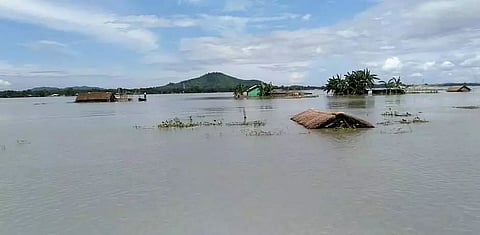
- Home
- Live Blog
- Breaking News
- Top Headlines
- Cities
- NE News
- Sentinel Media
- Sports
- Education
- Jobs

A scheduled visit of an Inter-Ministerial Central Team (IMCT) to the flood-affected areas in Assam brings an opportunity for the State government to push for release of adequate compensation by the central government for the damage caused by ravaging waves of floods. The State government estimated the damage at Rs 2300 crore in its interim report. Beyond the routine estimation of the damage, identifying the reasons for institutional failures of the state government to utilize the allocated fund for flood management programmes in the past is critical to making a pragmatic assessment. The Central government in 2019 decided to depute IMCT twice to a State affected by natural calamity of severe nature. Accordingly, the IMCT is now deputed immediately in the aftermath of a natural calamity of severe nature to make first-hand assessment of the damage. It is a departure from earlier practice of the central government waiting for submission of a detailed memorandum by the affected state before deputing an IMCT for flood damage assessment and relief operations. The new guidelines require the IMCT to visit the state for a second time for detailed assessment after submission of the memorandum by the state government for making final recommendations for allocation of additional central funds. This, however, requires the Assam government to prepare a detailed memorandum on war footing so that the IMCT can undertake its second visit at the earliest. This will help reduce time in IMCT making final recommendations to the High-Level Committee of the central government for allocation of additional central fund. Lower fund allocation by the Central government against the amount sought by the State government for flood damage repair is often attributed to non-submission of details at micro levels.The State government needs to impress upon the IMCT on the need to allocate timely release of fund for restoration of the damaged infrastructure. This year's flood caused breaches in 212 embankments, damaged 1720 roads, 182 bridges and culverts. If the breaches in the embankments are not plugged in time, then the State will be left vulnerable to a worse flood situation next year. Ninety per cent of the 423 embankments in the State have outlived their spans and therefore are prone to frequent breaches.
The State must put in place a transparent mechanism of early submission of schemes for repairing and strengthening of the embankments to facilitate quick release of fund well ahead of onset of the monsoon season. Submission of utilization certificates is key to timely release of fund by the central government. Every single rupee allocated and spent must be accounted. Official records show that of the total 141 works under flood management programme approved under the XI and XII Plan for an estimated cost of Rs 2838 crore, Assam could complete only 94 works and only Rs 813 crore was released during these twoplan periods. A report of the Comptroller and Auditor General (CAG) on schemes for flood control and flood forecasting States that these projects were to be completed within two to three years and requirement of funds in each year was to be provided in the annual budget by the State Government. The CAG report highlighted that insufficient flow of fund adversely affected the implementation of schemes and there was a shortfall in release of Central assistance by 60 per cent while the State Government also did not release 84 per cent of the allocated budget provision. The Water Resource Department spent 50.75 per cent of total expenditure of Rs 280.28 crore in the month of March alone against the 30 selectedprojects during 2008-16. During 2013-15, almost entire (99.77 per cent) expenditure amounting to Rs. 60.88 crore was incurred in March. It also came to light that Assam did not furnish any audited statement of expenditures in any of the years between 2007-08 and 2015-16 against Rs 813 crore released by the Central government. There can be no excuse for such inadequacies to continuein implementation of the flood management programmes. Timely submission of utilization certificates by executing departments and agencies can help monitor the progress of work and evaluate utilization of released fund. This will be possible only when both the central and the state government show no leniency over delay in submission of the utilization certificates. Making available detail information onplanning and execution of flood management work and utilization of fund in the public domain can help bring in more transparency and public scrutiny. Transparency and public participation in flood management work will help overcome the institutional deficiencies. Any demand for higher allocation of central fund for flood management will be justified only when the state ensures timely and judicious utilization of every single rupee already released by the central government. The central government too shares an equal responsibility to ensure this.